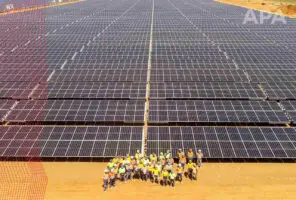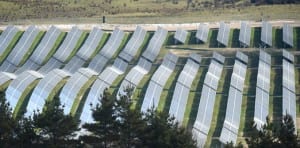 Yesterday we explored the Victorian government’s upcoming Renewable Energy Action Plan, examining the measures that the State government could take to promote new renewable energy projects.
Yesterday we explored the Victorian government’s upcoming Renewable Energy Action Plan, examining the measures that the State government could take to promote new renewable energy projects.
But as we explained in that article, the transformation and decarbonisation of our energy supply also requires a plan to retire the state’s outdated and polluting coal-fired power stations.
The graph below highlights the source of Victoria’s greenhouse pollution. The annual emissions from just four coal fired power stations comprise nearly half the state emissions.
On an emissions intensity basis, Hazelwood and Yallourn are amongst the least efficient coal plants in the world – around 1.5 tonnes of CO2 per MWh – and they’re right here on our doorstep.

As well as causing greenhouse and air pollution, big, dirty and old coal generators are crowding out investment in renewable energy with Victoria estimated by the Australian Energy Market Operator to have 2 GW excess generation capacity.
With the Federal Coalition’s removal of a carbon price and their unwillingness to implement any credible climate policy which would place a burden on coal generators, state leadership to facilitate coal retirement and community transition is essential. Fortunately, state governments have all the policy levers they need at their disposal.
So far we’ve seen the closure of a number of small higher-cost coal-fired power stations, including the closure of Energy Brix and Anglesea in Victoria. Both closures were announced suddenly, in response to low wholesale electricity prices. Both closures inflicted significant pain on workers and affected communities in the absence of any transition plan.
Now Victoria is left with four large power stations (Hazelwood, Yallourn, Loy Yang A and Loy Yang B) with high emissions and low running costs, all hoping that one of the other three will blink and close first to make their own business more profitable.
Without a circuit breaker these power stations could limp on for years, delaying investment in new renewable energy projects and then perhaps closing suddenly in response to changing market conditions, a looming major maintenance event, or a major failure of equipment (with serious safety risks to workers, as occurred at Northern power station in South Australia last year). Such an unplanned closure would have dramatic implications for workers and the Latrobe Valley.
It is a far more responsible course of action for the State government to outline an agenda for a smooth transition towards clean energy by gradually withdrawing coal generation and creating room for new renewable energy investment. This might involve encouraging the staged closure of the oldest and dirtiest units at our oldest and dirtiest power stations.
Yallourn has four 400 MW units and Hazelwood has eight 200 MW units, so there is the ability to commence retirement of a number of units now and stage closure over three or four years while embedding transition and economic diversification plans in the Latrobe Valley.
The Andrews government could use a number of measures to encourage the withdrawal of capacity. The simplest and cheapest would be introducing emissions performance standards linked to a decarbonisation target for the state. Standards could be embedded in Victoria’s Climate Change Act or the Environment Protection Act (both also under review at the moment), and ratchet up over time to progressively retire each of the State’s four coal-fired power stations, and eventually gas-fired power stations too.
This approach would complement (and likely reduce the cost of) efforts to accelerate new renewable energy build, with a clear schedule for power station retirement and new capacity requirements.
A retirement schedule would also kick-start transition planning for coal workers and Latrobe Valley community. Over the past six years there has been an awful lot of talk about the need for transition planning and some short lived processes to develop a plan for the region. Part of the reason these attempts have been fledgeling has been that in the absence of clear timelines for closure it has been difficult to attract the necessary resources for, and commitment to, the development of a transition plan.
Closure planning and transition planning need to work hand-in-hand. This will require local forums and consultation processes, perhaps a Latrobe Valley transition committee, and serious money on the table from both government and industry to implement economic diversification strategies.
Having been involved deeply in many of these transition conversations over the past decade there appear to be two elements to a transition plan that enjoy strong support from nearly all stakeholders.
Firstly a comprehensive rehabilitation plan for each of the mines and power stations will create hundreds of jobs over many years and good social and environmental outcomes for the local community. It is encouraging that the second Hazelwood Mine Fire Inquiry has highlighted the inadequacy of all mine rehabilitation plans in the Valley and is likely to lead to much higher rehabilitation standards and bonds.
Secondly, some workforce portability amongst the generators would provide the opportunity for younger workers who lose their job at the power stations which close first (eg Hazelwood and Yallourn) to be offered jobs at other power stations like Loy Yang A and B, while an older worker at Loy Yang should be able to participate in redundancy offers made by the closing generators.
Exploring such options will require innovation and an open mind. It is all too easy to maintain a hands off approach to both power station retirement and transition planning, but that does no favours at all to the Latrobe Valley community who already experience high disadvantage across a range of socio-economic indicators.
The Andrews Government could explore policy measures other than emissions performance standards to facilitate orderly coal plant closure. Frank Jotzo’s recent paper suggesting generators should contribute to a fund which then assists the first generator to exit has attracted much interest and makes a lot of sense.
Generators like AGL and Energy Australia have been well aware of brown coal oversupply and barriers to exit for some time and have been highlighting the need for government intervention.
Through its Renewable Energy Road map and climate change strategy, the Andrews government could use both the ‘stick’ of emissions performance standards, and the ‘carrot’ of some kind of brokered deal (as is happening with the Andrews Government’s Forest IndustryTaskforce) to get generators and other key stakeholders into the room to make meaningful decisions about power station closure and community transitions.
Victoria has the dirtiest power stations in the world in our backyard. It’s great that politicians are excited about the jobs and investment that flow from new renewable energy projects. But attracting renewable energy investment and retiring dirty coal power stations are two sides of the same coin, and we need both if we are to clean up our economy.
Mark Wakeham is CEO of Environment Victoria, one of Australia’s leading environmental charities.







